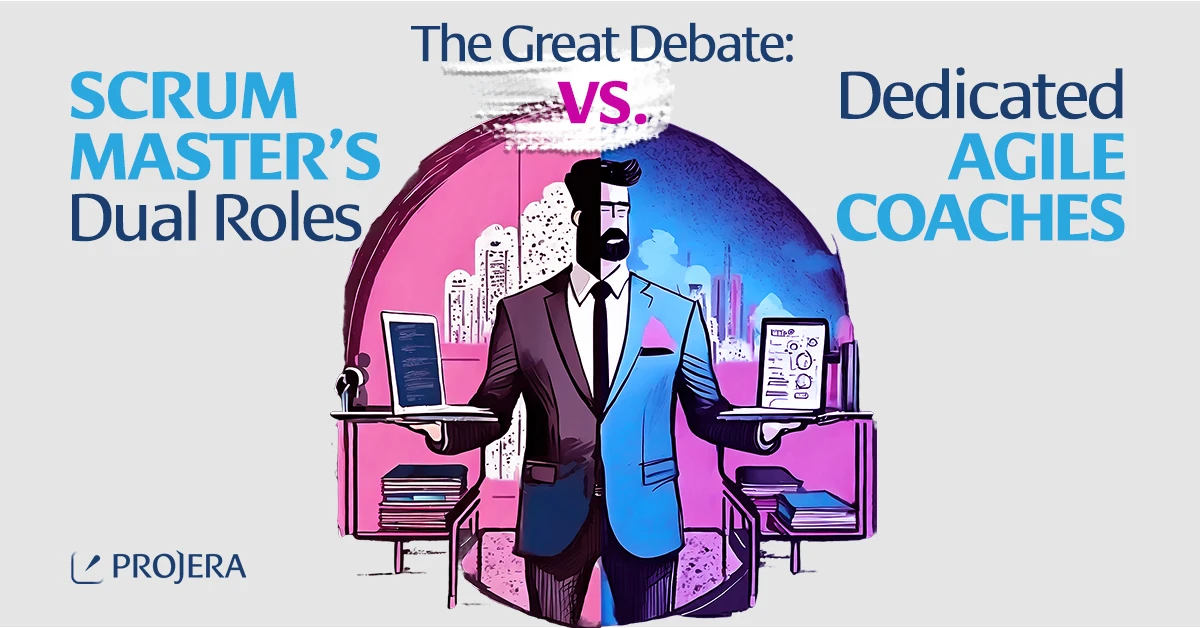
The Great Debate: Scrum Master’s Dual Roles vs. Dedicated Agile Coaches
As the Chief Human Resources Officer (CHRO), it’s essential to continually evaluate team structures and roles to ensure efficiency and productivity in the organization. One such debate that often emerges in Agile environments is the role of the Scrum Master (SM). Should the Scrum Master split their time between team tasks and SM duties, or should the organization invest in dedicated Agile Coaches, foregoing the SM role altogether? Let’s dissect the tradeoffs.
The Dual Role of the Scrum Master: Benefits and Challenges
Benefits
- A Scrum Master who also serves as a regular team member is deeply embedded in the team. They understand the team dynamics, the challenges faced, and are more in tune with the team’s needs.
- Having an individual who plays a dual role can be more cost-effective than hiring two separate individuals for the roles.
- Balancing team tasks with SM duties allows the individual to have a broader perspective on team objectives, ensuring that Scrum practices align directly with project goals.
Challenges
- Wearing multiple hats means the Scrum Master’s attention is divided. They might not always be available for immediate Scrum-related queries or issues.
- Balancing the responsibilities of regular team tasks with Scrum Master duties can be overwhelming, leading to potential burnouts.
- Mastery in one’s domain doesn’t necessarily translate to expertise in Scrum methodologies. The dual role might lead to compromises in one area or the other.
Dedicated Agile Coaches: The Pros and Cons
Pros:
- Dedicated Agile Coaches are experts in Agile methodologies. They bring a wealth of knowledge, best practices, and experiences to the table, which can elevate the team’s Agile maturity.
- Being external to the team’s day-to-day tasks, Agile Coaches can offer a neutral, unbiased perspective on challenges and solutions.
- Without the burden of regular team tasks, Agile Coaches are more available to address Agile-related concerns, mentor team members, and ensure Agile principles are consistently applied.
- Agile Coaches can potentially serve multiple teams, providing insights and ensuring Agile consistency across the organization.
Cons:
- Not being embedded in a specific team might result in a detachment from intricate team dynamics, making some solutions less tailored.
- Hiring seasoned Agile Coaches might be more costly than relying on existing team members to assume Scrum Master responsibilities.
- Teams accustomed to having an embedded Scrum Master might resist the idea of an external coach, seeing them as outsiders.
The CHRO's Perspective: Key Considerations
Organizational Goals: The decision should align with the organization’s long-term objectives. If the organization aims to become a beacon of Agile excellence, investing in dedicated Agile Coaches might be the way forward.
Budgetary Constraints: Financial considerations cannot be ignored. CHROs must weigh the immediate benefits of a dual-role Scrum Master against the potential long-term gains of dedicated Agile Coaches.
Team Maturity: Newly-formed Agile teams might benefit from a dedicated Scrum Master who can guide them through the early stages. In contrast, mature teams looking to elevate their Agile practices might gain more from an Agile Coach’s expertise.
Organizational Culture: The decision should also reflect the organization’s culture. A culture that values deep specialization might lean towards dedicated Agile Coaches, while a culture that appreciates multi-skilled individuals might favor the dual-role approach.
Feedback and Iteration: Like any other HR decision, it’s crucial to gather feedback, measure outcomes, and be willing to iterate. Whether choosing dual-role Scrum Masters or dedicated Agile Coaches, regular check-ins and reviews will ensure the decision remains aligned with the organization’s evolving needs.
Middle Ground? A Potential Hybrid Approach
One potential solution could be a hybrid model where both roles coexist. Newly-formed or less mature teams could have a dual-role Scrum Master, ensuring close-knit guidance. At the same time, dedicated Agile Coaches could work with multiple teams, especially mature ones, elevating the organization’s overall Agile practices.
This approach provides a nurturing environment for new teams while ensuring that mature teams continue to grow in their Agile journey. Over time, as teams evolve, the structure can be re-evaluated and adjusted accordingly.
Ending Words
The debate between retaining dual-role Scrum Masters or migrating towards dedicated Agile Coaches is not one-size-fits-all. As a CHRO, the decision requires a delicate balance of understanding the organization’s goals, team needs, budgetary constraints, and long-term vision.
While both models have their merits, the ultimate decision should aim to foster an environment where teams can thrive, Agile methodologies are upheld, and the organization continues its journey towards Agile excellence. Remember, in the Agile world, adaptability is key – be ready to inspect, adapt, and evolve as needed.



